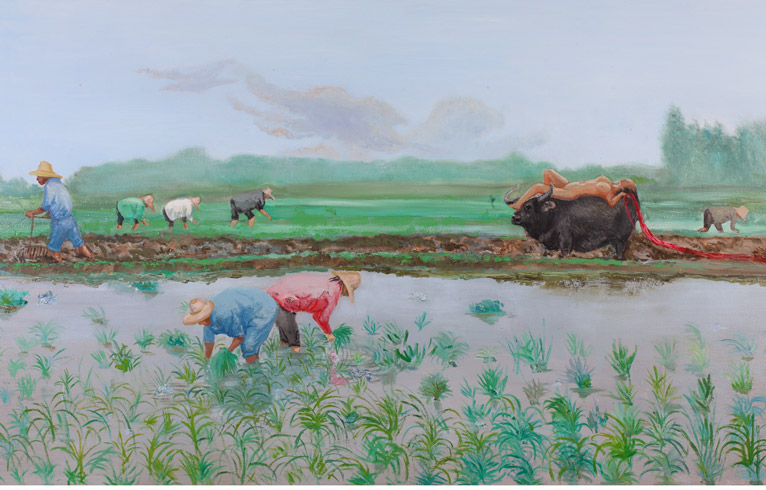DUAN JIANYU: THE SEDUCTION OF VILLAGE
| March 23, 2011 | Post In LEAP 7

In “The Seduction of Village” some new ideas arise that are worthy of attention. Due to Duan Jianyu’s bias towards text and narration, general commentary may liken her work to contemporary rhetoric—which, in some respects, it embodies. In one narrative series, Duan depicts a village woman nursing—a simple image that reappears before three separate backgrounds: a still white lake, a cold blue night, and a dappled meadow. For two other paintings—a southern village scene of rice transplantation, a lonely dusk falling on the surface of the sea—she uses a surrealistic, yellow-skinned nude female form to construct another of her hidden narratives. Upon viewing this small sample, and with the diverse range of other media (works made of cardboard, rock candy, and ceramic clay) at the exhibition site, it becomes clear: this is a multifaceted narrative text, and one intimately linked to Duan’s own private experiences.
But contemporary art is ultimately neither rhetoric nor semiotics. There is something transcendent in Duan Jianyu’s paintings, whereby the works themselves cast a shadow over the feminist interpretations so often applied to them. At the same time, her work possesses a dark, uniquely feminine temperament—at least in the present exhibition. My affinity for this exhibition lies in the fact that I immediately associate her Returning Home No. 3 with Chen Baoyi’s Hong Kong Terminal from the 1940s, not only due to the similarity of the two works’ familiar southern straw hats, but more so in how Duan’s use of color and engagement with characters and composition results in a sort of defamiliarization; it doesn’t feel like a contemporary work, but a painting from China’s Republican era.
This speculation resurfaces upon continued observation of the exhibition. In her nursing woman series, Duan Jianyu implicitly sinicizes the classic Western motif of Madonna and child. The figure of the rural woman does not emerge from reality either; rather, its unadorned simplicity echoes one of Pan Yulin’s female forms. Yet Duan’s techniques make use of an Eastern sentiment, as thin coats of color and an opaque, exposed canvas endow the painted surface with an alienating sense of adornment and structure. This treatment of elemental details can be traced to the history of modern Chinese painting. This is true of one painting especially, in which the artist entirely misappropriates Wu Guanzhong’s formalistic approach, using line drawings to represent the folk dwellings of Jiangnan.
In weaving her own obscure textual narratives, Duan Jianyu has yet another, more profound intention with this exhibition. It may not be a new cultural aspiration, as she has raised the question of the ethnicity of oil painting many times before, and now an atmosphere of impetuousness often leads us to overlook this “outdated” concept. Her works are reminiscent of ancient flower-bird paintings, thereby establishing a link to tradition; does she hope to unveil a new approach? Would this kind of mentality allow her to find inspiration at the dawn of Chinese modernist painting?
If this is the case, people will certainly sit up and take notice. Duan Jianyu’s art always possesses something transcendent. Even so, she must still consider and respond to the question of her method’s efficacy. Though contemporary art is distinct from rhetoric, this notion is a mere vision, an ideal. Contemporary problems, be they political, philosophical, cultural, artistic, or architectural, are all ultimately absorbed into discursive analytical frameworks. It is thus difficult for art to escape conceptualization and interpretation. When this artist, attempting to grasp or already familiar with the rules of the contemporary discourse game, utilizes some artistic resource, how should the critic talk about it? Rather than using tired postmodern terms like “parody,” “appropriation,” “satire” and “metonymy” to provide smug, shallow interpretations of her paintings, is there some other way? Pu Hong

